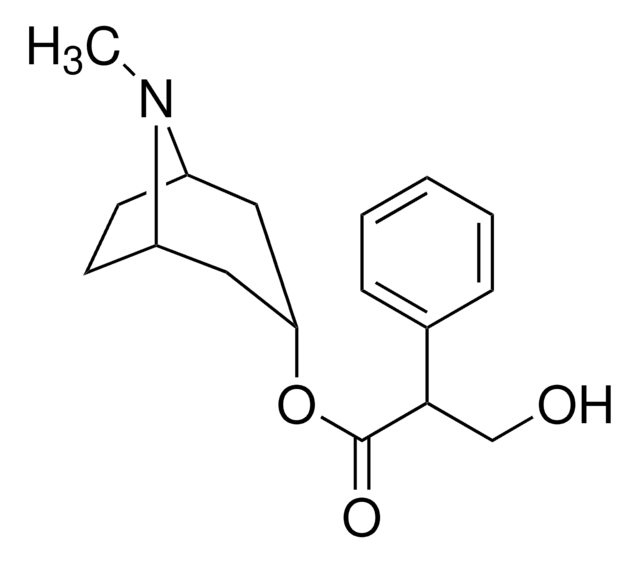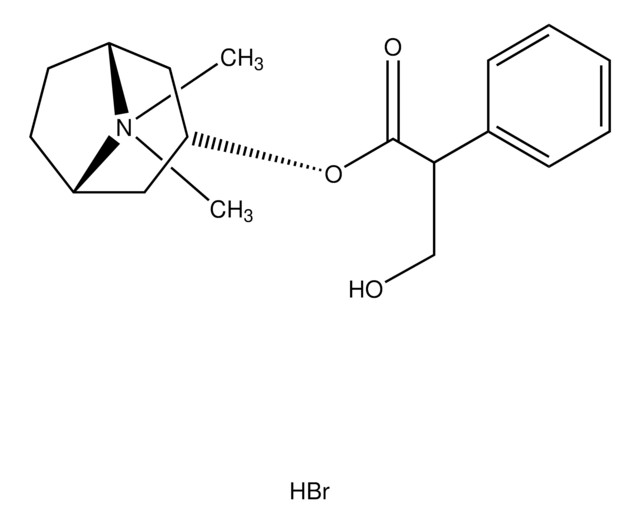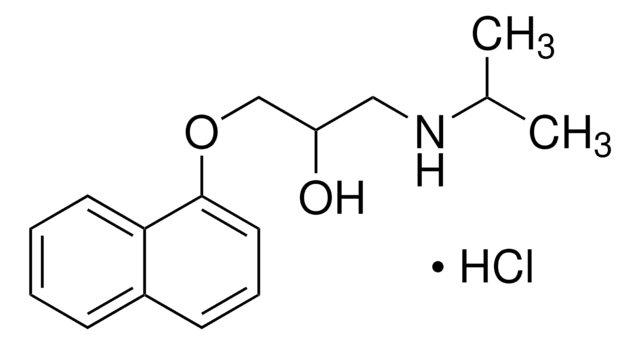A0132
Atropine
≥99% (TLC), powder
Synonym(s):
Hyoscyamine, Tropine tropate, endo-(±)-α-(Hydroxymethyl)benzeneacetic acid 8-methyl-8-azabicyclo[3.2.1]oct-3-yl ester
About This Item
Recommended Products
Assay
≥99% (TLC)
form
powder
color
white
solubility
H2O: 2 mg/mL
dilute aqueous acid: soluble
ethanol: soluble
SMILES string
CN1[C@H]2CC[C@@H]1C[C@@H](C2)OC(=O)C(CO)c3ccccc3
InChI
1S/C17H23NO3/c1-18-13-7-8-14(18)10-15(9-13)21-17(20)16(11-19)12-5-3-2-4-6-12/h2-6,13-16,19H,7-11H2,1H3/t13-,14+,15+,16?
InChI key
RKUNBYITZUJHSG-SPUOUPEWSA-N
Gene Information
human ... CHRM1(1128) , CHRM2(1129) , CHRM3(1131) , CHRM4(1132) , CHRM5(1133) , LOC730413(730413)
mouse ... Chrm1(12669)
rat ... Chrm1(25229) , Chrm2(81645) , Chrm3(24260) , Drd2(24318) , Htr1a(24473)
Looking for similar products? Visit Product Comparison Guide
General description
Application
- as a tastant to analyse the bitter taste perception in Drosophila larvae
- as a muscarinic acetylcholine autoreceptors (mAChRs) antagonist to investigate the involvement of individual mAChR subtypes in the control of synapse elimination
- to investigate the pathways of serotonin (5-HT) action in zebrafish hearts
Biochem/physiol Actions
Features and Benefits
Reconstitution
Signal Word
Danger
Hazard Statements
Precautionary Statements
Hazard Classifications
Acute Tox. 2 Inhalation - Acute Tox. 2 Oral
Storage Class Code
6.1A - Combustible acute toxic Cat. 1 and 2 / very toxic hazardous materials
WGK
WGK 3
Flash Point(F)
Not applicable
Flash Point(C)
Not applicable
Personal Protective Equipment
Choose from one of the most recent versions:
Already Own This Product?
Find documentation for the products that you have recently purchased in the Document Library.
Customers Also Viewed
Our team of scientists has experience in all areas of research including Life Science, Material Science, Chemical Synthesis, Chromatography, Analytical and many others.
Contact Technical Service









